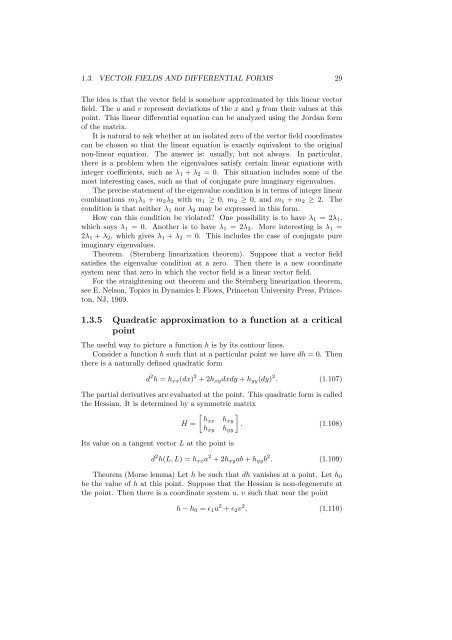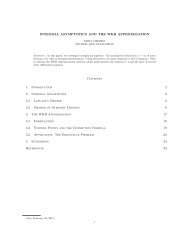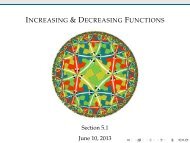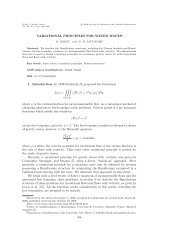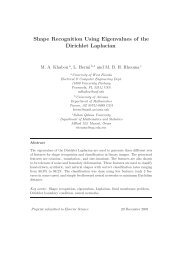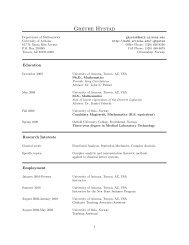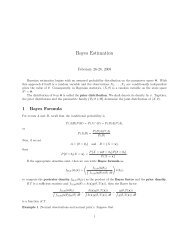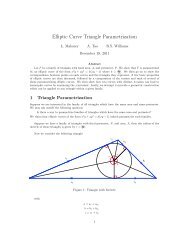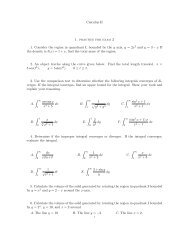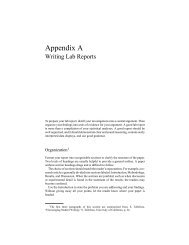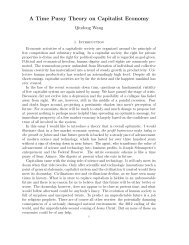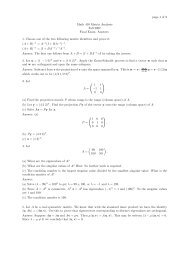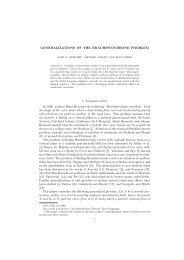Methods of Applied Mathematics Lecture Notes
Methods of Applied Mathematics Lecture Notes
Methods of Applied Mathematics Lecture Notes
Create successful ePaper yourself
Turn your PDF publications into a flip-book with our unique Google optimized e-Paper software.
1.3. VECTOR FIELDS AND DIFFERENTIAL FORMS 29The idea is that the vector field is somehow approximated by this linear vectorfield. The u and v represent deviations <strong>of</strong> the x and y from their values at thispoint. This linear differential equation can be analyzed using the Jordan form<strong>of</strong> the matrix.It is natural to ask whether at an isolated zero <strong>of</strong> the vector field coordinatescan be chosen so that the linear equation is exactly equivalent to the originalnon-linear equation. The answer is: usually, but not always. In particular,there is a problem when the eigenvalues satisfy certain linear equations withinteger coefficients, such as λ 1 + λ 2 = 0. This situation includes some <strong>of</strong> themost interesting cases, such as that <strong>of</strong> conjugate pure imaginary eigenvalues.The precise statement <strong>of</strong> the eigenvalue condition is in terms <strong>of</strong> integer linearcombinations m 1 λ 1 + m 2 λ 2 with m 1 ≥ 0, m 2 ≥ 0, and m 1 + m 2 ≥ 2. Thecondition is that neither λ 1 nor λ 2 may be expressed in this form.How can this condition be violated? One possibility is to have λ 1 = 2λ 1 ,which says λ 1 = 0. Another is to have λ 1 = 2λ 2 . More interesting is λ 1 =2λ 1 + λ 2 , which gives λ 1 + λ 2 = 0. This includes the case <strong>of</strong> conjugate pureimaginary eigenvalues.Theorem. (Sternberg linearization theorem). Suppose that a vector fieldsatisfies the eigenvalue condition at a zero. Then there is a new coordinatesystem near that zero in which the vector field is a linear vector field.For the straightening out theorem and the Sternberg linearization theorem,see E. Nelson, Topics in Dynamics I: Flows, Princeton University Press, Princeton,NJ, 1969.1.3.5 Quadratic approximation to a function at a criticalpointThe useful way to picture a function h is by its contour lines.Consider a function h such that at a particular point we have dh = 0. Thenthere is a naturally defined quadratic formd 2 h = h xx (dx) 2 + 2h xy dxdy + h yy (dy) 2 . (1.107)The partial derivatives are evaluated at the point. This quadratic form is calledthe Hessian. It is determined by a symmetric matrix[ ]hxx hH =xy. (1.108)h xy h yyIts value on a tangent vector L at the point isd 2 h(L, L) = h xx a 2 + 2h xy ab + h yy b 2 . (1.109)Theorem (Morse lemma) Let h be such that dh vanishes at a point. Let h 0be the value <strong>of</strong> h at this point. Suppose that the Hessian is non-degenerate atthe point. Then there is a coordinate system u, v such that near the pointh − h 0 = ɛ 1 u 2 + ɛ 2 v 2 , (1.110)


